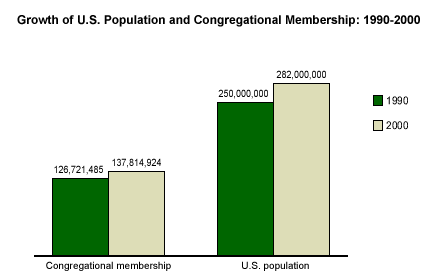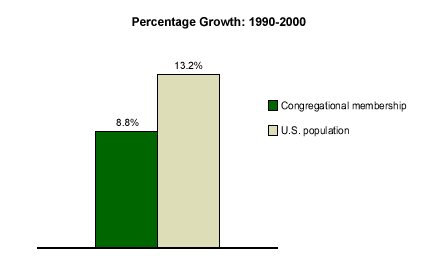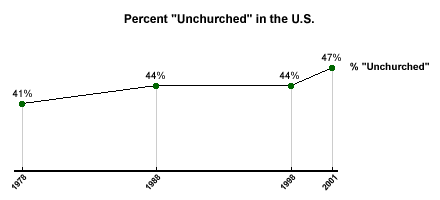Religious leaders of mainline Protestant churches may have been alarmed last month when the American Religion Data Archive released statistics on U.S. congregational membership showing that churches in this tradition have declined in the last 10 years. Evangelical Protestant congregations on the other hand, grew during this period.
The study, Religious Congregations and Membership in the United States: 2000, by the Nashville-based Glenmary Research Center, is conducted every 10 years. According to the data, Catholic churches saw a 16.2% increase in members, and Jewish membership also rose, by 2.7%. But a closer look at the data suggests that organized religion in America is in fact losing ground.
According to the study, overall membership in religious congregations in the United States increased by 8.8%, from 126,721,485 in 1990 to 137,814,924 in 2000. However, the U.S. population increased at a faster rate, growing 13.2% during the past decade -- from 250,000,000 to 282,000,000. The U.S. Hispanic population grew 47% during that time -- given that most Latin American immigrants come from predominantly Catholic countries, the 16.2% increase among Catholics isn't especially notable -- in fact, it's surprising that it wasn't considerably higher.

Overall, comparisons between the Census data and statistics on religion indicate that:
- While organized religion did see increases in the past decade, the overall result was a decline in the percentage of the population that claims adherence to a particular religion.
- The number of "unchurched" -- or those who do not belong to a particular faith community -- increased during the decade.

These comparisons confirm a trend that Gallup has been tracking for nearly 25 years: Both the numbers and percentage of unchurched Americans has been on the upswing (see Related Item). In "The Unchurched American," a 1978 report published by the Princeton Religion Research Center, the unchurched were defined as those who answered "no" to one or both of the following questions: "Do you happen to be a member of a church or synagogue?" or "Apart from weddings, funerals, or special holidays, such as Christmas, Easter or Yom Kippur, have you attended the church or synagogue of your choice in the past six months, or not?"
In 1978, 41% fit the definition of unchurched*. This proportion grew slightly to 44% in 1988**, a point at which it remained in a survey taken 10 years later, in 1998***. The most recent survey, taken in December 2001, produced a slightly higher figure, 47%^.

Here are a few issues for religious leaders to consider:
Congregational growth has come largely from those already disposed toward organized religion. The increased number of adherents to some religious faith groups comes more at the expense of other groups than from the conversion of the unchurched. This is apparent from the fact that the rate of growth of all organized religious congregations combined has not kept up with general population growth. It is also reflected in the number indicating that the growth of Evangelical Protestant congregations has come primarily at the expense of mainline Protestant congregations.
Why are Evangelical Protestant congregations growing and mainline Protestant congregations declining? Gallup research into the nature and role of engagement within congregations (see Related Items) strongly suggests that it has very little to do with theology or doctrine, but has a great deal to do with the engagement level of congregation members. Congregations whose members are engaged will grow, and those whose members are not engaged will not -- regardless of denomination, theology, or doctrine.
One of the key factors in engagement is clear expectations of membership. In addition to the fact that evangelical churches place more emphasis on reaching out to non-members, they also tend to have a more sharply defined theology and ethic, a trait that lends itself more readily to the communication to members of very clear expectations. Mainline churches, on the other hand, have a more difficult task in delineating expectations out of a more broad-based theological position. Congregations that have clearly defined expectations tend to have a more engaged congregation than those that do not -- regardless of theological position.
*Findings are based on in-person interviews with 3,062 U.S. adults, aged 18 and older, conducted in more than 300 scientifically selected localities across the nation April 14 through May 1, 1978.
**Findings are based on in-person interviews with 2,556 U.S. adults, aged 18 and older, conducted in more than 300 scientifically selected localities across the nation March 11-20, 1988.
***Results are based on telephone interviews with 1,016 national adults, aged 18 and older, conducted June 22-23, 1998. For results based on the total sample of national adults, one can say with 95% confidence that the margin of sampling error is ±3%.
^Results are based on telephone interviews with 1,019 national adults, aged 18 and older, conducted Dec. 14-16, 2001. For results based on the total sample of national adults, one can say with 95% confidence that the margin of sampling error is ±3%.
